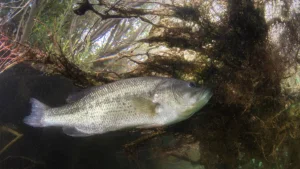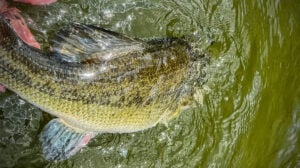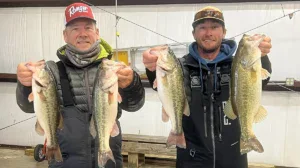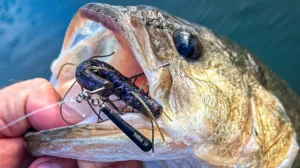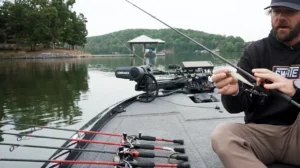The trout has always been associated with the finer things in life. Heck, the mere mention of the species conjures up images of Scottish Royalty fly fishing the fabled River Spey or maybe even Brad Pitt discussing the shadow cast on the banks of Montana’s Gallatin River. (Yeah, now you want to watch A River Runs Through It again. You’re welcome.) While I greatly enjoy some high-brow trout fishing on the fly or with artificials, I would consider myself a charter member of the Worm Dunker’s Association. After all, there’s a reason live bait, like fresh-dug crawlers, is so effective: Trout are instinctively drawn to the natural scent and movement of live prey.
Whether it’s nightcrawlers, minnows, crayfish, and even leeches, live bait triggers an immediate feeding response in trout, making them a perfect option for any angler in pursuit of a session full of bent rods.
The best part about using live bait tactics for stream trout is that it’s dang easy to get started. Below, you’ll find everything you need for an action-packed outing on the stream.

Finding Hot Live Bait Trout Locations
We’ll be focusing on trout that live in streams and river systems, which means current is always key when scouting productive spots. In general, you’ll want to keep an eye out for three things: holes, current breaks, and confluence points.
Holes
A hole in a river system is simply a deeper section of the riverbed, often formed by a series of rapids upstream. For trout, these holes offer two things: a place to rest out of the current and a prime spot to ambush prey. Of course, “deep” is a relative term. On some of my favorite trout streams, a 2-foot hole can be just as productive as a 10-foot hole in larger rivers. Holes are especially crucial during warm water periods, as the extra depth provides cooler, better-oxygenated water, creating an oasis for trout.
Current Breaks
Think of a current break as a buffet line for trout, where fast-moving water is slowed down by a rock, log, or some other obstruction. This creates a zone of gentler water where fish can rest while waiting to ambush prey being carried by the main flow. Some current breaks are obvious, but many are subtle, so it’s important to stay sharp. Those less noticeable breaks, though easy to miss, can hold plenty of trout.

Confluence Points (Feeding Hotspots)
There’s nothing quite as exciting for a trout angler as finding a confluence point where a smaller stream merges into a larger river. These dynamic junctions mix different water temperatures and bring in a wealth of nutrients, creating feeding hotspots. The merging currents disorient baitfish and other prey, offering trout easy meals. Confluence areas often come with the bonus of holes and current seams, making them the complete package.
Additionally, any of the types of structure mentioned above can be boosted by the presence of wood, large rocks, or in some cases, aquatic river grass. A good study session on Google Earth can certainly give you plenty of information on a specific section of the river, however, there is no substitute for putting on hiking boots and logging the miles.
Tackle: Gearing Up For Live Bait Trout
There’s no need to break the bank when choosing a rod and reel combo for stream trout fishing. Personally, I prefer a fast-action rod with just enough backbone to muscle a big fish out of heavy currents. Keep in mind that many trout streams are narrow and overgrown, which makes casting space tight. Before you commit to a rod, think carefully about going longer than 6 feet — it could save you a lot of frustration untangling your line from a patch of prickers and box elders.

As for reels, I’ve learned the hard way that a good day on the stream often means my gear gets plenty of gravel and sand exposure. With that in mind, I usually opt for a 500-size reel that’s on the lower end of the price spectrum.
When it comes to line, trout can be extremely line-shy, especially in heavily pressured areas. That’s why I always spool up with high-quality fluorocarbon in the 5#-8# range, depending on the size of the fish I expect to encounter. This helps ensure a stealthy presentation and a touch of abrasion resistance if I am fishing around wood and rock cover.
Rigging Up : Live Bait Trout Rigs
As anglers, myself included, we often tend to overcomplicate things. When it comes to rigging up for live bait trout, it’s best to stick to the basics and rely on a few time-tested trout fishing rigs.
Float Rig

More often than not, I have found stream trout to be extremely lazy, meaning they would prefer to wait for a meal to float by them than actively hunt. From this experience, I will begin exploring likely target areas by making a few passes with a float rig.
Components:
- Float: Thill Premium Balsa Slip Float
- Bobber Stop: VMC SSB Sinker Stops
- Sinker: Bass Pro Shops Reuasable Split Shot Weights
- Hook: Size 12-8 Gamakatsu Octopus Hook
Begin by sliding a bobber stop onto your line, far enough up to make sure you have plenty of room to work. From there, thread on a slip float of choice and pinch on a split shot, preferably of the lightest weight possible that will keep your bait drifting at the desired depth. Lastly, tie on the hook. One tip is to never be afraid to move the bobber stop up or down to experiment with depth. Often, the devil is in the details and these quick tweaks can be critical to securing bites.
To fish the float rig, simply make a cast ahead of the piece of structure you are trying to hit. Next, with an open spool, let the float make its way down the current. Be sure to monitor the float, as any drag or line friction coming out of the guides will make the presentation look unnatural and limit bites.
Bites can come in the form of complete “takedowns” or the float simply stopping before being slowly pulled under. Hooksets are free, so swing at any irregularity in the drift.
Split Shot Rig

When trout are bottom-hugging, the best way to stay snag-free and get down in the water column is the split shot rig. Just like the float rig, always use the lightest weight possible, as the sound of weights hitting rocky bottoms can spook especially wary fish. This is a great secondary approach if the float rig has not gotten any attention.
Components
The only rigging required is to tie on your hook and attach an appropriately sized split shot. Keep in mind that in nature, it is very rare that bait will stay in place on the bottom. Always make sure that your bait can be moved by the current, which can require a bit of experimentation with weight selection and spacing.
Weightless Rig

Remember, trout are experts on what natural baits look like when being carried by current. As anglers, we can’t perfectly recreate this, but we sure can try. The weightless rig is exactly what it sounds like it is: no weight, just a hook. The point is to keep things as realistic as possible.
Components:
The weightless rig is used for two purposes: casting at visibility feeding trout, and free drifting through likely areas. When sight fishing, the advantage of going weightless is there is no excess terminal tackle to make any additional sound. This often allows an angler to make repeated casts at the same fish. In terms of free-drifting the weightless rig, it is important to note that you won’t be able to cast a substantial distance with no weight. That means the weightless rig is best suited for lean waterways.
Live Baits for Trout
Nightcrawlers

Crawlers will catch a trout 365 days a year with ease. When hooking, I like to barely run the point of the hook through either end of the crawler. This allows the worm to fully extend, yielding impressive action. Depending on the day, I will alternate between full crawlers and halves. You can
When using the weightless rig, I always use a full crawler, because the added bulk lets the bait get down toward the middle of the water column.
If you’re interested in catching your own bait, you can check out our article on catching your own worms and shiners.
Shiners

No matter where you fish, trout will eat shiners with ferocity, since native baitfish make up a good portion of their diet once they begin to mature. While it is always possible to catch all sizes of trout on baits upwards of 5 inches, the smaller the bait, the more bites you tend to get.
Hook placement on shiners is a hot topic among anglers; I firmly believe in lightly hooking the bait in front of the dorsal fin. The weight of the hook towards the head makes the bait swim down and it’s also far enough back to ensure good hooksets, no matter how the trout eats the bait.
The list does not end with shiners and nightcrawlers; trout will also eat natural baits like crayfish, leeches, madtoms, and Hellgrammites. While many anglers think of trout as picky eaters, they will eat just about anything that’s available to them in surplus.
Artificial Lure Options

While nothing can truly replace the effectiveness of live bait, I have found three baits in particular that are extremely natural in appearance and make good substitutes.
Rapala Countdown Minnow
The controlled sinking action and lifelike action on the retrieve makes the Rapala Countdown Minnow a great choice to quickly cover water and pick off active fish. I prefer the CD-1 model, because the 1-inch length and extremely small profile makes it easy to fit the bait into slim spots.
Z-Man Finesse TRD
You can’t beat the subtle action of a falling Z-Man Finesse TRD, and it’s been a treat seeing the bait slowly migrate from my smallmouth box into my trout kit. I find it important to use vibrant colors, like bubble gum, so trout will be able to see it from far distances in just about any water condition.
Missile Jigs Ike’s Micro Football Jig
When trout are super sluggish, a bottom contact bait, like a football jig, is a great way to pick up a few extra bites. The Ike’s Micro Football Jig has an excellent hook and a thin skirt that keeps the presentation on the light side. More often than not, I do not use a trailer and let the undulation of the frog hair skirt seal the deal.
When it comes to stream trout, live bait tactics offer an easy and incredibly efficient way to fish. By focusing on strategic locations like deep holes, current breaks, and confluence points, anglers can maximize their chances of finding numbers of trout. With the right gear, simple rigs, and a selection of live bait, I can all but guarantee some very reliable trout fishing.




